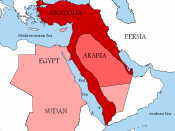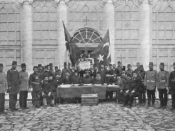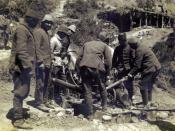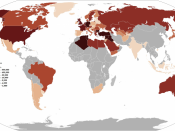The Image of the Turks Throughout history the Ottoman Empire was looked upon as having a barbaric and lustful people. This was the opinion of a majority of Western Europeans. Andrew Wheatcroft wrote The Ottomans to show exactly how the Europeans did look on the Turks. This paper shows how the feelings toward the Ottomans created stereotypes that lasted centuries.
The Europeans looked upon the Turks as lower forms of human beings, much like Adolf Hitler viewed the Jews during World War II. Europeans were prejudiced towards the Turks because they did not understand the Muslim people or their religion. Wheatcroft used a quote by Francis Bacon to show the mood of the Europeans in the sixteenth-century: Without morality, without letters, arts or sciences; a people that can scarce measure an acre of land or an hour of the day; base and sluttish in building, diet and the like; and in a word, a very reproach to human society"æit is truly said concerning the Turk, where the Ottoman's horse sets his foot, people come up very thin (231).
The Turks were considered to be a very dangerous group of people. The Europeans were really scared of them. They would meet in battle and thousands of "crazy"ÃÂ Turkish warriors called bashi-bazouks would appear, rampaging with swords in the shape of a crescent. The Europeans had never seen any thing like this before and they didn't know what to think. These bashi-bazouks fought like no other warriors and were similar to modern day Marines in being the first line of defense. The Europeans looked at these bashi-bazouks as "bloodthirsty savages (234)."ÃÂ They were accused of raping the women and pillaging the cities they would conquer, knowing good and well that the Europeans would do the same when they conquered a city or nation. Wheatcroft writes, The naive folk drawings from the Greek War show Egyptian soldiers and janissaries killing Greek women, while Greeks (in their white kilts) are only shown attacking enemy soldiers. Yet we know that many thousands of Turkish women and children were killed, often with appalling savagery, in the Morea (234).
In India, when the British were a central power from 1857-8, there were similar acts of savagery performed by the British. They were on a "campaign of racial terror, hanging almost any Indians on whom they could get their hands in an orgy of vengeance (235-6)."ÃÂ They sought to torture these people because hanging was too quick a death for such "terrible"ÃÂ people. One example of the torture inflicted upon the Indians is included in Wheatcroft's book: The most ceremonious form of dispatching mutineers to strap them to the front of a cannon, and blow them in half, often so that their scattered remains would splatter the faces of their former comrades, lined up to observe the execution (236).
These acts of savagery by the Europeans were just as bad and sometimes worse than what was done by the Turkish people. The European's fear of these "mad"ÃÂ Turks caused a lot of racial strife in which the Europeans turned every aspect of the Ottoman Empire into a reproach of society. These views of the Turkish people did not fade away with the fall of the Ottoman Empire. Even to this day, Europeans carry a certain fear of the Turks. Wheatcroft explains: The image of the Turk, dissolving and constantly reforming, will never be free from its deep roots: In European fears of sex and violence looming out in the East (239).
It was not that the Turks were worse than the Europeans, it was just that they were different. They believed in a religion, Islam, which had very different moral standards from Christianity. Since it wasn't the same belief of the Europeans and their Catholic religion, it was considered wrong. This is similar to the way mainstream Christians view the religions that consider the handling of snakes to be part of their worship service. These unusual religions are often the victims of stereotypes and misunderstandings concerning their beliefs.
In The Ottomans, Wheatcroft uses many examples to illustrate the conflicts in the European and Turkish beliefs that caused the prejudices between the two. He proves that stereotypes are not always to be taken as fact. The only way to get past labels on other people is to find out for yourself who people really are.





